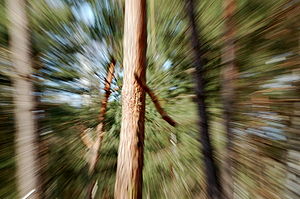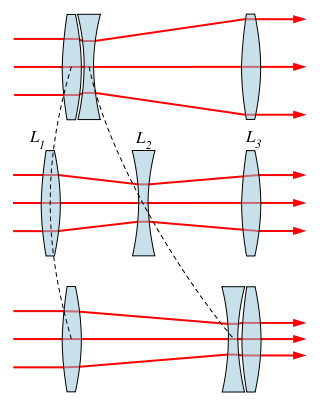- Zoom lens
-
A zoom lens is a mechanical assembly of lens elements for which the focal length (and thus angle of view) can be varied, as opposed to a fixed focal length (FFL) lens (see prime lens). They are commonly used with still, video, motion picture cameras, projectors, some binoculars, microscopes, telescopes, telescopic sights, and other optical instruments.
A true zoom lens, also called a parfocal lens, is one that maintains focus when its focal length changes. A lens that loses focus during zooming is more properly called a varifocal lens.
Contents
Applications
Zoom lenses are often described by the ratio of their longest to shortest focal lengths. For example, a zoom lens with focal lengths ranging from 100 mm to 400 mm may be described as a 4:1 or "4×" zoom. The term superzoom or hyperzoom is used to describe photographic zoom lenses with very large focal length factors, typically more than 4× and ranging up to 15× in SLR camera lenses and 36× in amateur digital cameras. This ratio can be as high as 100× in professional television cameras.[1] As of 2009, photographic zoom lenses beyond about 3× cannot generally produce imaging quality on par with prime lenses. Constant fast aperture zooms (usually f/2.8 or f/2.0) are typically restricted to this zoom range. Quality degradation is less perceptible when recording moving images at low resolution, which is why professional video and TV lenses are able to feature high zoom ratios. Digital photography can also accommodate algorithms that compensate for optical flaws, both within in-camera processors and post-production software.
Some photographic zoom lenses are long-focus lenses, with focal lengths longer than a normal lens, some are wide-angle lenses (wider than normal), and others cover a range from wide-angle to long-focus. Lenses in the latter group of zoom lenses, sometimes referred to as "normal" zooms[citation needed], have displaced the fixed focal length lens as the popular one-lens selection on many contemporary cameras. The markings on these lenses usually say W and T for "Wide" and "Telephoto". Telephoto is designated because the longer focal length supplied by the negative diverging lens is longer than the overall lens assembly (the negative diverging lens acting as the "telephoto group").[2]
Some digital cameras allow cropping and enlarging of a captured image, in order to emulate the effect of a longer focal length zoom lens (narrower angle of view). This is commonly known as digital zoom and produces an image of lower optical resolution than optical zoom. Exactly the same effect can be obtained by using digital image processing software on a computer to crop the digital image and enlarge the cropped area. Many digital cameras have both, combining them by first using the optical, then the digital zoom.
In addition to its photographic use, the afocal part of a zoom lens can be used as a telescope of variable magnification to make an adjustable beam expander. This can be used, for example, to change the size of a laser beam so that the irradiance of the beam can be varied.
History
Early forms of zoom lenses were used in optical telescopes to provide continuous variation of the magnification of the image, and this was first reported in the proceedings of the Royal Society in 1834. Early patents for telephoto lenses also included movable lens elements which could be adjusted to change the overall focal length of the lens. Lenses of this kind are now called varifocal lenses, since when the focal length is changed, the position of the focal plane also moves, requiring refocusing of the lens after each change.
The first true zoom lens, which retained near-sharp focus while the effective focal length of the lens assembly was changed, was patented in 1902 by Clile C. Allen (U.S. Patent 696,788). The first industrial production was the Bell and Howell Cooke "Varo" 40–120 mm lens for 35mm movie cameras introduced in 1932. The most impressive early TV Zoom lens was the VAROTAL III from Rank Taylor Hobson from UK built in 1953. The Kilfitt 36–82 mm/2.8 Zoomar introduced in 1959 was the first varifocal lens in regular production for still 35mm photography. The first modern film zoom lens was designed around 1950 by Roger Cuvillier, a French engineer working for SOM-Berthiot. It had an optical compensation zoom system. In 1956, Pierre Angenieux introduced the mechanical compensation system, enabling precise focus while zooming, in his 10x lens released in 1958. Angenieux received a 1964 technical award from the academy of motion pictures for the design of that 12-120 zoom lens.
Since then advances in optical design, particularly the use of computers for optical ray tracing, has made the design and construction of zoom lenses much easier, and they are now used widely in professional and amateur photography.
Design
There are many possible designs for zoom lenses, the most complex ones having upwards of thirty individual lens elements and multiple moving parts. Most, however, follow the same basic design. Generally they consist of a number of individual lenses that may be either fixed, or slide axially along the body of the lens. While the magnification of a zoom lens changes, it is necessary to compensate for any movement of the focal plane to keep the focused image sharp. This compensation may be done by mechanical means (moving the complete lens assembly while the magnification of the lens changes), or optically (arranging the position of the focal plane to vary as little as possible while the lens is zoomed).
A simple scheme for a zoom lens divides the assembly into two parts: a focussing lens similar to a standard, fixed-focal-length photographic lens, preceded by an afocal zoom system, an arrangement of fixed and movable lens elements that does not focus the light, but alters the size of a beam of light travelling through it, and thus the overall magnification of the lens system.
In this simple optically compensated zoom lens, the afocal system consists of two positive (converging) lenses of equal focal length (lenses L1 and L3) with a negative (diverging) lens (L2) between them, with an absolute focal length less than half that of the positive lenses. Lens L3 is fixed, but lenses L1 and L2 can be moved axially, and do so in a fixed, non-linear relationship. This movement is usually performed by a complex arrangement of gears and cams in the lens housing, although some modern zoom lenses use computer-controlled servos to perform this positioning.
While the negative lens L2 moves from the front to the back of the lens, the lens L1 moves forward and then backward in a parabolic arc. In doing so, the overall angular magnification of the system varies, changing the effective focal length of the complete zoom lens. At each of the three points shown, the three-lens system is afocal (neither diverging or converging the light), and so does not alter the position of the focal plane of the lens. Between these points, the system is not exactly afocal, but the variation in focal plane position can be small enough (~±0.01 mm in a well-designed lens) not to make a significant change to the sharpness of the image.
 Simplified zoom lens in operation
Simplified zoom lens in operationAn important issue in zoom lens design is the correction of optical aberrations (such as chromatic aberration, and in particular field curvature) across the whole operating range of the lens; this is considerably harder in a zoom lens than a fixed lens, which needs only to correct the aberrations for one focal length. This problem was a major reason for the slow uptake of zoom lenses, with early designs being considerably inferior to contemporary fixed lenses, and usable only with a narrow range of f-numbers. Modern optical design techniques have enabled the construction of zoom lenses with good aberration correction over widely variable focal lengths and apertures.
Whereas lenses used in cinematography and video applications are required to maintain focus while the focal length is changed, there is no such requirement for still photography, or if a zoom lens is used as a projection lens. Since it is harder to construct a lens that does not change focus with the same image quality as one that does, the latter applications often have lenses that require refocusing once the focal length has changed (and thus strictly speaking are varifocal lenses, not zoom lenses). As most modern still cameras are autofocus, this is not a problem.
Designers of zoom lenses with large zoom ratios often trade one or more aberrations for higher image sharpness. For example, a greater degree of barrel and pincushion distortion is tolerated in lenses that span the focal length range from wide angle to telephoto with a focal ratio of 10x or more than would be acceptable in a fixed focal length lens or a zoom lens with a lower ratio. Although modern design methods have been continually reducing this problem, barrel distortion of greater than one percent is common in these large-ratio lenses. Another price paid is that at the extreme telephoto setting of the lens the effective focal length changes significantly while the lens is focused on closer objects. The apparent focal length can more than halve while the lens is focused from infinity to medium close-up. To a lesser degree, this effect is also seen in fixed focal length lenses that move internal lens elements, rather than the entire lens, to effect changes in magnification.
Varifocal lens
Many so-called "zoom" lenses, particularly in the case of fixed lens cameras, are actually varifocal lenses, which gives lens designers more flexibility in optical design trade-offs (focal length range, maximum aperture, size, weight, cost) than true parfocal zoom, and which is practical because of auto-focus, and because the camera processor can move the lens to compensate for the change in the position of the focal plane while changing magnification ("zooming"), making operation essentially the same as a true parfocal zoom.[3]
See also
- Pan tilt zoom camera (PTZ)
- Professional video camera
- Tripod (photography)
- View camera
By focal length:
Focus attributes:
By system:
- List of Canon EF lenses
- Nikon F-mount
- Minolta AF
References
- ^ "DIGISUPER 100 xs". Canon Broadcast Equipment. http://www.canon.com/bctv/products/digi100xs.html.
- ^ Business and corporate aviation management: on demand air transportation By John J. Sheehan, page 521
- ^ Cavanagh, Roger (2003-05-29). "Parfrocal Lenses". Archived from the original on 2007-10-07. http://web.archive.org/web/20071007070643/http://www.rogercavanagh.com/helpinfo/30_parfocal.stm. Retrieved 2007-11-18.
- Kingslake, R. (1960), "The development of the zoom lens". Journal of the SMPTE 69, 534
- Clark, A.D. (1973), Zoom Lenses, Monographs on Applied Optics No. 7. Adam Hildger (London).
- Malacara, Daniel and Malacara, Zacarias (1994), Handbook of Lens Design. Marcel Dekker, Inc. ISBN 0-8247-9225-4
- "What is Inside a Zoom Lens?", Adaptall-2.com.
External links
- Principe de fonctionnement du variateur de champ afocal(fr)[1]
Categories:- 1932 introductions
- Photographic lenses
- Telescopes
- Television terminology
Wikimedia Foundation. 2010.





